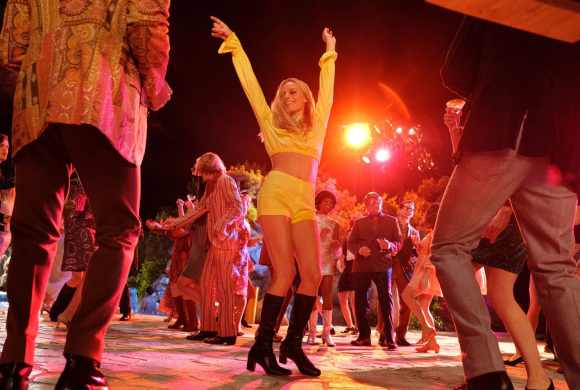
While Tarantino’s Once Upon a Time in Hollywood has been generally positively reviewed, its portrayal of Sharon Tate remains controversial. Some have criticized the film for Tate’s minimal dialogue, with one critic saying, “Tarantino’s portrayal of Tate as a lifeless doll is proof he has lost his touch.” Another critic says, “The film reduces Tate to a mute sex object and bit player within her own story.” If someone only views the film through the lens of whether Tate pushes the plot forward, I could see how someone might draw these conclusions. However, the film’s nontraditional plot consists of small character moments that don’t necessarily impact the unexpected finale.
Personally, I take issue that a woman in a short skirt with minimal dialogue is automatically categorized as a sex object—especially when there’s extensive evidence of character depth. Despite the biting reviews and Tate’s few lines, Once Upon a Time in Hollywood depicts Sharon Tate as a whole person, rather than reducing her to a victim or object, as illustrated in her slice-of-life story and non-dialogue-driven characterization. The film challenges the viewer’s expectations. In particular, it challenges viewer assumptions about Tate’s role as victim in a gruesome murder that ultimately eclipsed her career, accomplishments, and personhood.
Before discussing the evidence of Tate’s personhood in the film, let’s tackle the elephant in the room: Tate’s (lack of) dialogue and the Bechdel Test. The Bechdel Test was invented in 1985 by Alison Bechdel as a way to benchmark the way women appear in film and the roles they inhabit. In order to pass the Bechdel Test, a film must include at least two named female characters who talk about something other than a man. It sounds like a low bar, but it’s telling that few films pass. It’s meant to be a way to think about female representation in film rather than a measuring stick for whether a film can be considered “feminist” or even good. For context, many films with strong female leads, such as Gravity, Arrival, and Jackie Brown, fail the Bechdel Test. (See my review of Pacific Rim for another example.)
Does Once Upon a Time in Hollywood pass the Bechdel test? It does, barely. But more importantly, the test itself has made moviegoers more sensitive and attuned to watching out for female characters with dialogue. Overall, this is fantastic. It’s wonderful that so many representation discussions have stemmed from this test. However, it’s not the only yardstick with which to measure female depictions in film. It’s a popular framework because of its simplicity and because it’s shocking how many films fail it. Once Upon a Time in Hollywood exhibits other ways to show character depth.
As previously mentioned, Once Upon a Time in Hollywood‘s nontraditional plot contains small moments that lead to the end. In most films, individual scenes somehow add to the ending or push the plot further toward a resolution. In Once Upon a Time, we linger with characters for the purpose of seeing them as real humans. Just as we see Rick Dalton as a person rather than a celebrity divorced from real personhood, we see Sharon Tate as a person rather than a victim. To that end, we spend a lot of time with Sharon Tate, even though her activities have little intersection with the other two main characters. We watch Tate attend a party, buy a book, dance by herself in her bedroom, and go to a movie.
The film focuses on Sharon Tate’s life, rather than her death. In an interview, the director Quentin Tarantino says,
“I thought it would both be touching and pleasurable and also sad and melancholy to just spend a little time with her, just existing […] It’s a day in the life of all three of them, that Saturday in February. A day in the life, driving around, running errands, doing this, doing that, and just being with her. I thought that could be special and meaningful. I wanted you to see Sharon a lot, see her living life. Not following some story, just see her living, see her being.”
This perfectly encapsulates how I felt watching Sharon Tate. It would have been contrived and perhaps disrespectful to layer a plot onto her real life. However, by following a day in her life, we celebrate it and mourn it. By joining her in watching a real clip from one of the films she was in, we remember her not as the victim but as a talented actor and person. We share in the joy we see her experience as she watches her performance and reminisces about the training and hard work she put into the role. We witness her passion for her craft.
In the movie theater scene, I thought it was odd that she removed her shoes. Admittedly, I rolled my eyes. Anyone familiar with Tarantin’s work knows he has a thing for feet, and this felt a bit overboard, especially for a depiction of a real person. However, it turns out Sharon Tate really did walk around barefoot a lot. Apparently, she’d even put rubber bands around her ankles to make it look like she was wearing sandals so she could patron restaurants barefoot. Her dirty bare feet coupled with her large glasses in the movie theater highlights her humanity as a three-dimensional person. Both visuals undermine the blonde bombshell image—as does her loud snoring, which we hear in another scene. She’s a complex person, unwilling to conform to cultural norms or expectations.

Highlighting her individuality, Sharon Tate dances by herself in several scenes. You could choose to interpret this as performing for the male gaze, as some critics have. I agree with a critic from IndieWire who describes the Playboy Mansion party scene:
Anyone paying attention to Robbie’s dancing will notice how individualistic it is during the scene. Sharon Tate is seen vibrantly dancing in her own image and not associated with any men, which only stands out more when Steve McQueen (Damian Lewis) tells a partygoer about Tate’s romantic history. Basil [the choregrapher] said that dancing “was partnering, it was jitterbug” before the 1960s, but during the counterculture era it became “freedom — what the ’60s were about.” With dancers no longer holding hands, the “arms started to dance.” Such was the foundation of creating Robbie’s Playboy Mansion dance moves.
Tate’s un-selfconscious dancing at the Playboy Mansion and alone in her bedroom feel like a joyful expression of freedom rather than a display for others. Throughout the film, we see her cheerfully and sincerely appreciating art: music, movies, and books. Her dancing feels like a natural extension of that expression.
We learn more about Sharon Tate’s character when she quietly stops by a bookstore. She had set aside a copy of Tess of the d’Urbervilles by Thomas Hardy for her husband Roman Polanski. Sharon Tate bought this book for Polanski in real life, inspiring him to write the film Tess. In this gesture, we see her generosity and her intelligence. She seeks out literature with an understanding of a book’s potential for inspiration and adaptation—a creative partner to Polanski. Like many other details in the film (the ending!), knowing the truth about the real-life events makes a difference in how you experience and interpret the scenes.
Because of the many seemingly mundane moments we’re able to share with Tate throughout the film, I felt such relief at the end. Even for a moment, I loved picturing a reality in which she continued living and enjoying life. Her kindness and thoughtfulness seemed contagious, and I enjoyed thinking about the positive impact she could continue to have on others. For me, the ending was cathartic—and the film illustrated a day in the life of Sharon Tate beautifully.


